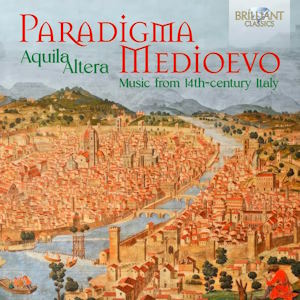
Paradigma Medioevo: Music from 14th-century Italy
Aquila Altera
rec. 2022, Monastero Fortezzo di Santo Spiritu, Ocre, Italy
Brilliant Classics 96922 [52]
The disc immediately made me think of David Munrow’s 1972 LP Ecco la primavera: both programmes begin with that particularly joyous song. Aquila Altera, the ensemble here, have also recorded, à la Munrow, three brilliant instrumental items, one of which lends the disc its title. They give us five Landini songs, some of them little known, and, unusually, three pieces by that shadowy but astonishingly original figure, Antonio Zacara da Teramo, which Munrow never did.
Let us unpack what we have here, and how the performers seem to view this music. There is an array of instruments amongst the eight players, and three voices. Have you ever come across a tammorra (a large, framed drum) or a ceccola (a small bagpipe)? I had to look them up. Or a flauto-doppio (a double pipe like an Aulos)? Check out Simore Martini’s painting in the Assisi Chapel (c.1320) St Martin divides his cloak with a beggar, in which this instrument is shown. We also have the usual fiddle, harp, portative organ and so on. Aquila Altera are aiming for colour and variety. I applaud.
Landini was blind from an early age, but his tomb describes him as ‘skilled in instrumental music, whom alone music has set above all other’. There is variety in the Landini tracks. I‘prego Amor e la vostre biltate is sung by three voices doubled by fiddle, recorder and organ. In Ochi dolenti miei there is a solo voice with the flauto-doppio and organ. The famous Questa fanciull’ Amor is played instrumentally with percussion. The instrumentalists also perform alone in three other pieces, including the incredibly energetic estampita Tre fontane.
I find myself not quite enamoured with soprano Maria Antonietta Cignitti’s rather thin tone, but the blend with Carlotta Colobo’s alto and Luca Cervoni’s tenor is well focused and satisfying. The last track comes off especially well. The canonic, bi-textual, three-part caccia Cacciando per gustar / Ay cinci, ay toppi is all about a rowdy marketplace, the earliest market known in music. I know this because I have another recording of the piece. Brilliant Classics sadly do not, as usual, supply any of the texts, but there is Arnaldo Morelli’s very thorough essay. The booklet is beautifully adorned by the famous 15th-century view of Florence, Pianta della Catena from c.1470, attributed to Francesco Rosselli.
I love the atmosphere of Florence even now. This music revolves around the city where Dante and Petrarch lived and died, and had left their celebrated poetic heritage. Landini and Andrea da Firenze – and other composers such as Jacopo da Bologna who wrote the madrigal Aquila altera – are the musical equivalents of those masters. I wish they were even more appreciated for their wonderfully shaped, memorable melodies. One can only hope that discs like this help enhance the reputation of Ars nova Italian music. It is a pity that this programme is not a little longer.
Gary Higginson
Help us financially by purchasing from


Contents
Francesco Landini (c.1325-1397)
Ecco la primavera
Antionio Zacara da Teramo (c.1360-1416)
Dicovi per certança
Andrea da Firenze (c.1350-1415)
Dolce speranza d’amoroso foco
anonymous
Chominciamento di goia (instrumental)
Francesco Landini
I’priego amor e la vostre biltate
Ochi dolenti miei che pur piangete
Questa fanciull’Amor, fallami pia
Antonio Zacara da Teramo
Non voler, donna
anonymous
Aquila aAltera
Francesco Landini
Adiu, adiu dous dame
anonymous
Amor mi fa cantar
Francesco Landini
Non creder donna
anonymous
Tre fontane
Antonio Zacara da Teramo
Cacciando pergustar / Ay cinci, ay toppi

















